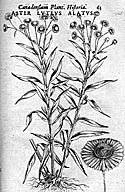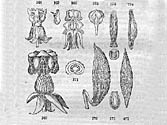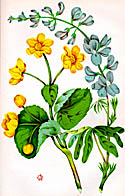Introduction
Planting the Seeds
Native Agriculture and Plant Use
Canadian Flora
Pioneer Gardening
19th Century Seed Catalogues
Cultivating the Garden
The Cultivators
Reaping the Harvest
Bibliography
Photos by Beth Powning
Other Gardening Sites
Acknowledgements |
Planting the Seeds
Canadian Flora
European gardeners were fascinated by the plants being discovered by early travellers to the New World. Native plants of North America were gathered first by the Jesuit missionaries who were encouraged to observe and collect them, and to test them in "holding gardens" until they could be sent back to France. Many of these plants ended up in the Jardin des plantes, also called the Jardin du Roi, for many years the most important garden in France. The result is that the botanical names for many North American wildflowers contain the words canadensis or canadense.
Most of the early explorers took artists along on their travels. Artists such as George Back and Robert Hood made detailed botanical drawings of the plants they saw.
Early in the 19th century, the passion for collecting was reaching its peak, and Europe was hungry for new plants and trees. Stories of the early North American naturalists who fed this passion are filled with physical discomfort and danger, competition and intrigue, and disappointing losses when plants and seeds were shipped across the ocean and either died or were lost on the voyage.
There now exist many flora describing the plants of Canada, from H.J. Scoggan's four-volume The Flora of Canada, to individual titles for each of the provinces and territories, as well as more narrowly based studies of interesting localities.
| The first book on the subject of plant life in Canada was written in Latin by a physician in Paris who had never even been to this country. Its illustrations are probably based on plants found in the famous Jardin des Plants. |
 |
Cornut, Jacques Philippe.
Iac. Cornuti Doctoris medici parisiensis Canadensium ... .
Paris: Venundantur apud Simonem Le Moyne, 1635. |
| Abbé Provancher was the earliest of the 19th-century naturalists in Quebec. His Flore canadienne is filled with clear, detailed, scientific descriptions of the plants of the region, illustrated with line drawings, many of which were borrowed openly from the American botanist Asa Gray. |
 |
Provancher, Abbé Léon.
Flore canadienne... .
Quebec: Darveau, 1862. |
 Catharine Parr Traill was not a botanist in the formal sense, but she was a keen observer and studied the plants of the region of Ontario around Peterborough. Published in the later years of her life, this volume is based on Traill's many years of observation and study, but is written in the friendly and charming style that marks all of her work.
"On light loamy or sandy soil our gay Lupine may be seen gladdening the wastes and purpling the ground with its long spikes of azure blue, white and purple flowers of many shades." |
 |
Traill, Catherine Parr.
Studies of Plant Life in Canada: or, Gleanings from Forest, Lake or Plain.
Ottawa: Woodburn, 1885, p. 68. |
 | John Macoun, Dominion Naturalist at the turn of the century, was one of the country's foremost botanists. His strength was as a collector and he was said to have amassed more than 100 000 specimens which formed the basis of the Dominion Herbarium. |
Waiser, W.A.
The Field Naturalist: John Macoun, the Geological Survey and Natural Science.
Toronto: University of Toronto, 1989.
|
|
